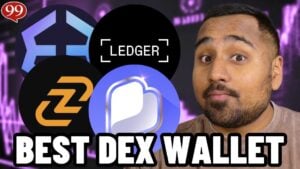
The clash Solana vs Ethereum lately sees the former triumph, if one considers, for example, the number of daily active users.
In fact, according to a recent chart by Blockchain Army, Solana has had 10 times more daily active users than Ethereum and Bitcoin for months now.
Solana vs Ethereum: the turning point
Always taking the number of daily active users as a reference point, the turning point occurred starting from January 2024.
The chart compares the DAU (Daily Active Users) of Solana, Ethereum, and Bitcoin from 2020 to today. In reality, the direct comparison should only be made between Solana, Ethereum, given that Bitcoin has very few smart contracts, little DeFi, and essentially no DEX.
The comparison was made by analyzing the on-chain data of daily active addresses.
Initially in 2020, Ethereum was clearly ahead, with about 700,000 daily active users, compared to a number for Solana close to zero. On the other hand, Solana is a crypto protocol that only started to gain popularity from 2021.
During 2022 and 2023, however, the average DAU of Solana have consistently grown, reaching those of Ethereum at the beginning of 2024.
Here there was a real turning point, with Ethereum’s DAU dropping below one million, and Solana’s soaring in a short time to reach a peak of over 5 million in September of the same year.
The growth of Solana
Note that the growth over time of Solana’s DAU has not been constant at all.
In reality, it was from 2021 to 2023, but in 2024 there was an incredible boom, most likely due to the mania of memecoin, the collapse of costs for creating new tokens, and Pump.fun.
Moreover, starting from 2024, there has also been a significant drop in DAU on Ethereum, with transaction fees even plummeting by 70%, to the lowest levels since 2020.
It is unlikely that the two things are uncorrelated, also because in the past it was mainly on Ethereum that new tokens were launched.
Therefore, 2024 was the year of Solana, with such an impressive growth that it even managed to compete with Ethereum.
The final showdown: Solana vs Ethereum
Both Solana and Ethereum are blockchain platforms, but they differ significantly in their architecture and priorities.
The most evident difference is the one concerning speed and especially transaction costs:
In fact, Solana is known primarily for its high transaction speeds and low fees, as it was specifically designed to quickly handle a large volume of transactions.
Ethereum, on the other hand, has historically always had difficulties with scalability, so much so that they had to resort to layer-2 solutions to solve the problem. The transaction speed is a bit slower compared to that of Solana, and the fees are higher, especially during periods of high network activity.
All this is due also and above all to the different consensus mechanism used.
Ethereum in 2022 transitioned to a classic Proof-of-Stake (PoS), while Solana employs a unique combination of Proof-of-History (PoH) and Proof-of-Stake (PoS). It is precisely this hybrid approach that contributes to its high throughput.
On the other hand, Ethereum still has a much larger and more established ecosystem, with a wide range of decentralized applications (dApp), decentralized finance protocols (DeFi), and non-fungible tokens (NFT). However, Solana’s ecosystem is growing rapidly, particularly in areas where high transaction speeds and low fees are crucial, such as DeFi and NFT.
It is important to highlight, however, that while Solana prioritizes scalability and speed, sometimes at the expense of a certain decentralization, Ethereum instead prioritizes decentralization and security. This has led in the past, for example, to Solana experiencing some issues with network outages, while Ethereum is widely considered more stable.
SOL vs ETH: the two native cryptos compared
As for the performance in the market of their respective criptovalute native, SOL and ETH, the differences in the long term appear smaller.
However, in the medium, and especially in the short term, they still appear significant.
For example, SOL recorded its all-time high value a few weeks ago, while ETH is still stuck at that of 2021.
Despite this, current prices in both cases are about 40% lower than the historical highs.
However, while in the last 30 days ETH is at -15%, SOL is at -30%, because even though they follow similar trends in the long term, in the short term they can also diverge significantly.
It is worth noting, however, that ETH has been on the crypto markets for ten years, while SOL only for half the time. In fact, compared to the initial prices, ETH is currently at +99,000%, while SOL is at +22,000%.

 8 months ago
49
8 months ago
49




 English (US) ·
English (US) ·